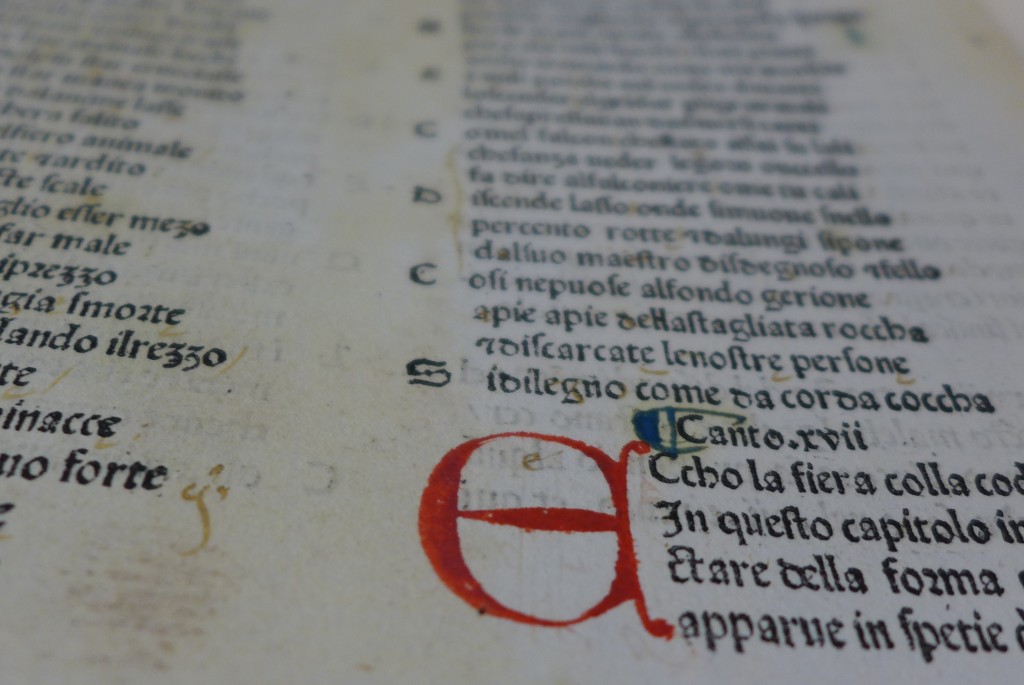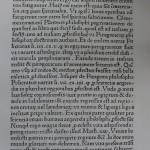Written by Erika Delbecque, UMASCS Librarian
Earlier this year, we shared some exciting early printing finds from the John Lewis Printing Collection on this blog. In the past few months, I have been researching these leaves, so that they can be catalogued and the collection can be made more accessible. In the first instance, I have been focusing on leaves from incunables.
The cradle of printing
Incunables, from the Latin incunabulum (“cradle”) are books that were printed in Europe before 1501, in the infancy of the art of printing with movable type, which was introduced by Johannes Gutenberg in ca. 1450. These books from the cradle of printing can give us a glimpse into the early stages of one of the most significant human inventions.
Often a hybrid between manuscript and print, with hand-painted initials and decorations sitting alongside the black ink of the printed text, incunables embody the gradual transition from a world where the manuscript was the prime medium for the transmission of knowledge to one where the printed word took on this crucial role.

Hand-painted initial and decoration (Beauvais, Vincent of. Speculum historiale. Strassburg: Johann Mentelin, 1473)
Some of these craftsmen reach an astonishing degree of esthetical perfection in those early stages. Consider, for example, the woodcut from a leaf from the famous Nuremberg Chronicle (1493) below, or the leaf from Plutarch’s Vitae illustrium virorum, printed by the Venetian printer Nicolas Jenson in 1478. The typeface that Jenson designed for his printing business would later be praised by William Morris for its elegance and beauty, and it continues to influence type design to this day.

Detail from a leaf from the Nuremberg Chronicle (Schedel, Hartmann. Liber chronicarum. Nuremberg: Anton Koberger, 1493)
We owe the survival of these leaves to the thriftiness of early modern craftsmen. Rather than wasting new paper, which was a relatively expensive commodity, bookbinders recycled leaves from earlier documents to reinforce the spine and covers of a book. Some of the leaves in our collection provide clues as to why they ended up in the bookbinder’s stack of wastepaper: the pages of this double leaf from Hypnerotomachia Poliphili, a romance that was printed by Aldus Manutius in 1499, are in the wrong order.

Pages printed in the wrong order (Colonna, Francesco. Poliphili Hypnerotomachia. Venice: Aldus Manutius, 1499)
Incunable leaves in the John Lewis Collection
Although it is uncertain how these leaves ended up in the collection of John Lewis (1912-1996), a typographer and graphic designer whose collection of ephemera we purchased in 1997, the foreword in his book Printed ephemera provides a clue:
A dozen years or so ago, I bought from a bookseller in Ipswich, Suffolk, an album compiled about the year 1820 by a Dr Lodge, sometime librarian to the University Library at Cambridge. Dr Lodge’s album contained a wide variety of printed matter including […] an Indulgence printed by Thierry Martens.
As librarian to a great library, Dr Lodge’s opportunities for collecting pages from damaged books and packings from broken bindings were extensive. It would seem that this particular Indulgence may well have lurked for three hundred years or more inside some vellum or calf-bound volume, doing duty for the paste-boards which in those days did not exist.
Thus, it is possible that these leaves spent centuries sitting undisturbed in the bindings of their younger relatives on the shelves of Cambridge University Library, before ending up here at the University of Reading through the rather dubious collecting efforts of this Dr Lodge…
On the trail of early printers
Identifying what work these leaves are part of often requires quite a bit of detective work, as the features by which an early printed book would normally be identified, such as the title page, the incipit or the colophon, are lacking.
The first step is the identification of the text. Search engines like Google are immensely useful for this purpose in many cases, but for more obscure texts skim-reading the pages or translating a part to form an idea of the content is more fruitful. This can be particularly challenging when dealing with a text in heavily abbreviated Latin, which many of these leaves contain! Then, a search on incunabula catalogues, such as the Incunabula Short Title Catalogue and the Gesamtkatalog der Wiegendrucke, will reveal which editions of this text were printed in the fifteenth century. Finally, a comparison with digitised copies, if available, will let you determine what edition the leaf was once part of.
Fifteen leaves have been identified in this way. They are currently being catalogued onto Enterprise, our library catalogue, and our holdings on the ISTC have been updated. However, four leaves remain unidentified. If this blog post has inspired you to try your hand at researching an incunable leaf, have a look at the photographs of the leaves below. Let us know in the comments section if you discover anything about them!
- Unidentified text, possibly papal decretals.
- Unidentified missal in Latin printed in red and black.
- Unidentified edition of Summa de exemplis by Giovanni da San Gimignano. May be early 16th century
- Latin text about Moses. Probably Italian.
References
Lewis, J (1976) Collecting Printed Ephemera. London: Cassell and Collier Macmillan.









Pingback: Incunables identified | Beckett, Books and Biscuits: University of Reading Special Collections